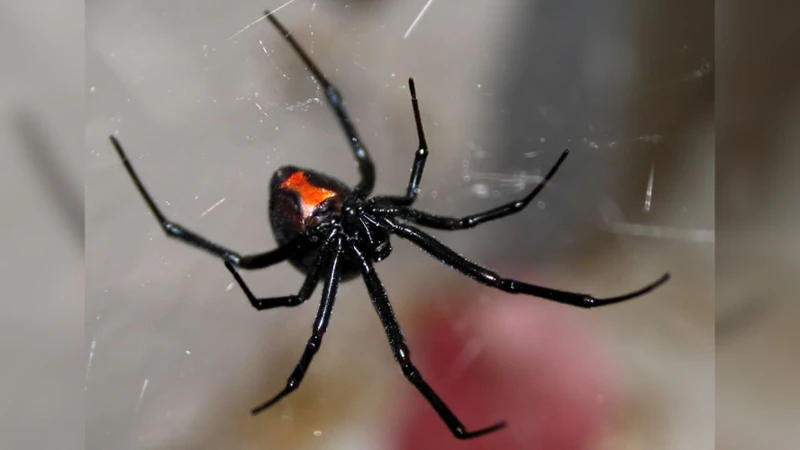As you explore the natural world, you may come across spiders with varying physical characteristics. However, few can match the distinctiveness of the juvenile black widow spider. These creatures possess unique features that set them apart from others. In this article, we will provide you with a detailed understanding of the physical characteristics of juvenile black widow spiders, so you can identify them with confidence and stay safe. Join us as we dive into the world of these fascinating arachnids.
What are Black Widow Spiders?
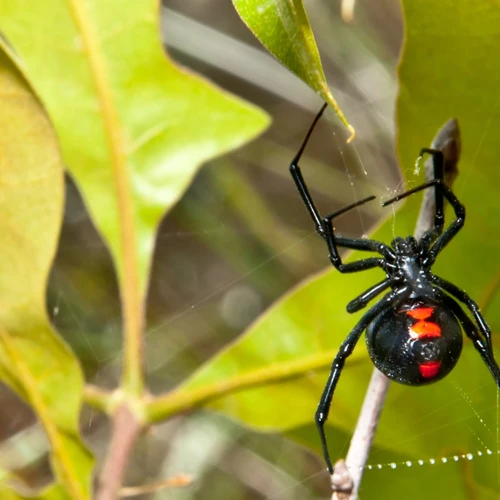
Black Widow Spiders are a regular feature of the arachnid family and are well-known for their dangerous venomous bites. These spiders are a part of the Latrodectus family, which translates to ‘hidden biter,’ and are found all over the world, with five different species regularly appearing in North America. These spiders are usually identified by the distinctive red hourglass shape on the underside of the abdomen, though their appearance is often confused with other spider species such as the false widow spider.
Black Widow Spiders possess unique physical characteristics that are used to identify the species. These characteristics vary from their adult to juvenile stages, along with differences based on location. Understanding their physical traits is necessary to identify them correctly and ensure the safety of humans from their dangerous bites. These physical characteristics include their body coloration, band patterns, abdomen shape, size, legs, egg sacs, body structure, sensory capabilities, venoms, and other traits making them distinct from other spiders.
The adult stages of Black Widow Spiders have shiny black bodies, and their hairless skin, along with red hourglass-shaped markings, make them easily identifiable. Additionally, the egg sacs of female Black Widow Spiders are quite distinctive in appearance, resembling white, papery cocoons, each of which can hold up to 750 eggs.
To deep dive into the physical characteristics of juvenile Black Widow Spiders, the next section of this article will explore their unique physical traits. Additionally, there are several other aspects of Black Widow Spiders that make them stand apart from other arachnids. These topics include size differences, identifying markings, the use of spider silk, sensory capabilities, behavioral traits, and more. If you’re interested in learning more, we highly recommend checking out this article on traits and classification of Black Widow Spiders, as it offers detailed insights on their fascinating characteristics.
Physical Characteristics of Adult Black Widow Spiders
One of the most well-known and easily recognized spiders in the world is the black widow spider. They are famous for their unmistakable black coloring, prominent shiny abdomen, and of course, their potent venom. Adult black widow spiders are easily identified by their physical characteristics.
Size
Adult female black widow spiders are much larger than males and can grow up to half an inch in body length. Males are smaller, measuring around one-quarter of an inch in length, but they have longer legs than females.
Body Structure
Black widow spiders have a distinct body structure that is differentiated from other spider species. They have a round, bulbous abdomen, and a small cephalothorax, which is the part of the body that holds the legs and the other appendages. They also have a hardened exoskeleton that provides the black widow spider with extra protection against predators and other environmental hazards.
Coloration
The black widow spider is commonly known for its black coloration, which is usually accompanied by red or orange hourglass-shaped markings on the underside of their abdomen. However, not all black widow spider species have this marking. Some species have other forms of markings and coloration.
Venom Glands
Although not a physical characteristic visible to the naked eye, the venom glands of adult black widow spiders are a significant feature of the species. The venom from black widow spiders is highly toxic and contains a neurotoxin that can cause muscle spasms, severe pain, and even death in some cases. However, it’s worth noting that black widow spiders do not always inject venom when they bite.
If you want to know more about the physical characteristics of black widow spiders in general, please read our comprehensive guide on the topic.
Juvenile Black Widow Spider Physical Characteristics
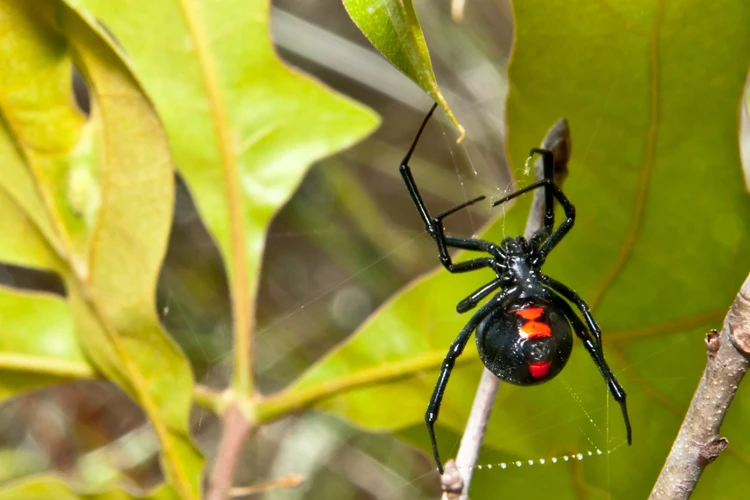
Juvenile black widow spiders have several distinct physical characteristics that help distinguish them from their adult counterparts. While juvenile black widows appear similar in some aspects to adult black widows, there are some notable differences that can aid in identification.
Body Coloration: The body coloration of juvenile black widows is different from adult black widows. Typically, juvenile spiders are lighter in color, often with a grey or brown hue. This lighter coloration often makes it difficult to differentiate between juvenile black widows and other types of spiders.
Band Patterns: Juvenile black widows have unique band patterns on their abdomen. While adult females feature a distinctive red hourglass shape on the underside of their abdomen, juvenile black widows often have white or yellow stripes across their body. The patterns on their abdomen can vary, making it difficult to identify them.
Abdomen Shape: The shape of the abdomen is different in juvenile spiders as well. While adult females have a round and bulbous abdomen, a juvenile black widow’s abdomen is often more elongated or slim. This is a fairly reliable way of identifying juvenile black widows.
Size: Juvenile black widows are much smaller than their adult counterparts, measuring between ¼ to ½ inch in length. This makes them difficult to identify, especially when young.
Legs: The legs of juvenile black widows are often of a lighter color than those of the adult spiders. Sometimes, they may still be in the process of developing the long spindly legs that are characteristic of adult black widows.
Egg Sacs: Female black widows produce egg sacs that are unmistakable and can be used as a way to identify juvenile spiders. These egg sacs are often round or oblong with a papery texture and are light brown in color.
While juvenile black widows share some similarities with adult black widows, they have several distinct physical characteristics that make them identifiable. These include differences in coloration, band patterns, abdomen shape, leg size, and egg sacs. It is important to be aware of these physical characteristics when identifying black widows and to exercise caution around these potentially dangerous spiders. If you would like to learn more about identifying markings of black widow spiders, click here.
Body Coloration
Juvenile Black Widow Spiders have a distinct look which sets them apart from their adult counterparts. One of the most noticeable features of a juvenile Black Widow Spider is its body coloration. Instead of the classic jet-black color of the adult, the juvenile’s body is covered in white and yellow stripes and spots.
These markings may serve as a warning to potential predators, as they appear similar to the markings of other venomous spiders and insects. The bright colors of the juvenile Black Widow Spider are believed to indicate their youthful nature, as these colors fade as the spider matures.
It is important to note that there is some variation in juvenile Black Widow Spider coloration depending on the species. For example, the Northern Black Widow Spider has fewer markings and may appear more uniform in color compared to its southern counterparts.
Understanding the differences in body coloration among juvenile Black Widow Spiders can be helpful in identifying them in the wild. Being able to recognize their unique markings can also prevent accidental bites. If you encounter a spider in the wild that matches this description, it is best to give it a wide berth and observe it from a safe distance.
To learn more about the anatomy, physiology, and behavior of Black Widow Spiders, check out some of our other articles on related topics, such as /black-widow-venom-glands/ or /sensory-capabilities-black-widow-spiders/.
Band Patterns
Juvenile black widow spiders are known for their distinct band patterns that are different from those found in adult black widow spiders. These patterns are found on the back of the spider’s abdomen. The band patterns are used to help identify the species of spider, as well as to indicate whether the spider is male or female.
The juvenile black widow spiders have five white or yellowish bands located across their black colored abdomen. These bands are wider in the front and narrower towards the back. The first two bands appear to be broken in the middle and have an hourglass shape. The remaining three bands form a continuous pattern across the abdomen.
The band patterns of the juvenile black widow spider differ from those of the adult female black widow spider, which has a classic hourglass-shaped mark on the underside of her belly. The male black widow spider has a slightly different pattern of bands, with two large spots and several smaller spots on its belly.
These band patterns provide important information about a spider’s age and sex. The bands can help to distinguish juvenile black widow spiders from other similar species. For example, the six-spotted fishing spider looks similar to the juvenile black widow spider, but has six spots on its abdomen and lacks the hourglass shape.
These band patterns are used to warn predators that the spider is venomous and potentially dangerous. The bright colors and distinct patterns on the body act as a warning to potential predators to stay away. If threatened, the spider may raise its abdomen to expose the bands as a display of aggression.
The band patterns on juvenile black widow spiders are an important physical characteristic that helps to distinguish them from other species of spiders. These patterns serve as a warning to predators and provide information about the spider’s age and sex. If you want to learn more about the size differences between black widow spiders and other types of spiders, check out this article /size-differences-black-widows/.
Abdomen Shape
When it comes to the physical characteristics of juvenile black widow spiders, one of the key differences from their adult counterparts lies in their abdomen shape. While adult female black widow spiders have a round, bulbous abdomen, juveniles have a smaller, more elongated abdomen that is more cylindrical in shape.
This difference in abdomen shape can actually be helpful in identifying juvenile black widows. Since their bodies are more proportional, their distinctive coloration and band patterns may be easier to spot. Additionally, the smaller abdomen size means that juveniles are less likely to be mistaken for other spider species with similar coloring and banding.
It’s worth noting that the shape of the abdomen will also change as juvenile black widows mature and reach adulthood. As they grow, their abdomens will become rounder and more bulbous, taking on the more characteristic shape of adult black widows.
The distinct shape of the black widow spider’s abdomen is just one of the many remarkable adaptations that this species has developed over time. From using their silk for various purposes to relying on their exoskeletons for survival, black widows have evolved an incredibly unique body structure and set of behaviors that allow them to thrive in their environments. To learn more about these adaptations, check out our articles on black widow spider silk uses, how the exoskeleton protects the black widow spider, and a comparison of spider body types.
Size
Juvenile Black Widow Spiders are significantly smaller than their adult counterparts. Their size ranges from 1/20 inch to about 1/8 inch in length. This is approximately the size of a pinhead, making it difficult for the naked eye to spot them.
Since the size of the juvenile black widow spider is considerably smaller compared to an adult, it can be challenging to identify them. However, one distinguishing characteristic of the juvenile black widow spider is their coloration and band patterns that distinguish them from other spiders.
It is important to note that the size of the juvenile black widow spider gradually increases as it grows older until it attains its full length and size of about 1.5 inches. During this growth process, there are several physical characteristics that occur or change, such as the band patterns on the spider’s abdomen and body.
The size difference between juvenile black widow spider and adult black widow spiders can be attributed to their body structure and survival mechanisms. Adult black widow spiders typically have larger and stronger bodies, which are adaptations that help them in mating, reproduction, and survival.
So, if you spot a small and dark-colored spider that has distinctive band patterns on its body and legs, then it might be a juvenile black widow spider. However, it is important to exercise caution when trying to identify it as there are other spider species that share similar physical characteristics.
Legs
The legs of juvenile black widow spiders are one of their most distinct physical characteristics. One notable feature is their length, which can be up to three times the length of their body. The legs are thin and more delicate than those of their adult counterparts, giving them a fragile appearance.
One interesting feature of juvenile black widow spider legs is the presence of fine hairs on the surface. These hairs are believed to help the spider sense its surroundings, which can be crucial for survival.
The legs are also the location of the spider’s distinct coloring. The femur, or upper portion of the leg, is typically black or dark brown with distinctive stripes or spots that can be yellow, white or light brown. The tibia, or lower portion of the leg, tends to be lighter in color, ranging from yellowish to a pale brown or even white.
The legs of juvenile black widow spiders are also adorned with small spines, usually located on the underside of the tibia. These spines may be used for gripping and holding prey while the spider injects its toxin.
The legs of juvenile black widow spiders are a key feature in identifying them. Their length, delicate appearance, fine hairs, and distinct coloring make them a fascinating and easily recognizable part of these spiders’ anatomy.
Egg Sacs
One of the physical characteristics that can be used to identify juvenile black widow spiders is the egg sacs that they produce. These egg sacs are typically spherical in shape, with a diameter of around 2 to 4 millimeters. They are made of a tough, papery material that is light in color and can range from beige to light brown.
The inside of the egg sac is filled with anywhere from around 50 to 400 eggs, depending on the size of the spider and the amount of food that it has consumed. The eggs themselves are fairly small, around 0.5 millimeters in diameter, and are usually a pale yellow color.
Interestingly, juvenile black widow spiders are capable of producing their own egg sacs as early as two to three months after they have hatched. This is because their lifespan is generally much shorter than that of adult spiders, and they need to reproduce as quickly as possible in order to ensure that their species survives.
It is important to note that it is not recommended to handle or disturb any egg sacs that you may find, as they may contain live black widow spider eggs. If you suspect that you have spotted a juvenile black widow spider or its egg sacs, it is best to contact a professional pest control company to safely remove the spider and its eggs from your property.
How to Identify Juvenile Black Widow Spiders
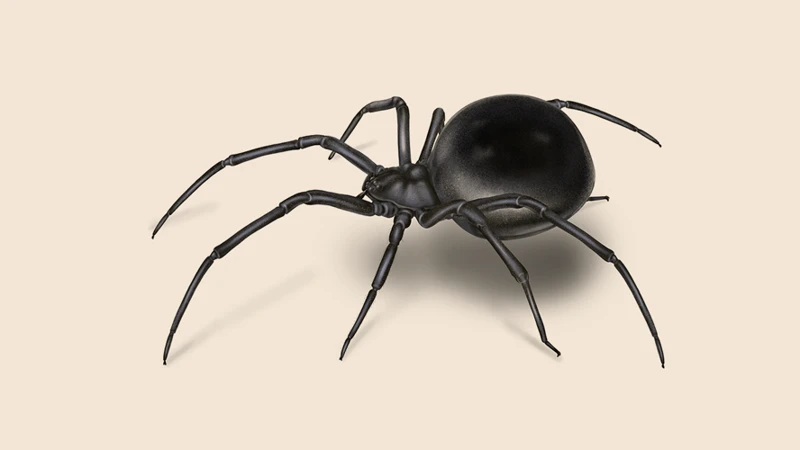
Identifying juvenile black widow spiders can be a challenging endeavor. However, there are several features that distinguish them from other spider species, as well as from adult black widow spiders. In this section, we will explore some of the key characteristics you can use to identify juvenile black widow spiders using coloration and patterns, physical characteristics, and behavioral characteristics.
Coloration and Patterns
Juvenile black widow spiders have a distinct coloration that differs from that of adult black widow spiders. While adult black widow spiders have a shiny black body with a red hourglass marking on their abdomen, juvenile black widow spiders have a more muted coloration. Instead of the shiny black of the adult spiders, juvenile black widows have a dull black or dark brown body that may have white or yellow stripes on their dorsal surface. The dorsal stripe pattern is one of the key features that set juvenile black widows apart from adult black widow spiders.
Physical Characteristics
In addition to their distinct coloration, juvenile black widow spiders have several physical traits that distinguish them from other spider species. One of the most notable features is their small size. While adult black widow spiders can grow to be up to 1.5 inches in length, juvenile black widows are typically less than half that size. They also have a rounder, less elongated abdomen than adult black widow spiders. Juvenile black widows may also have incomplete band patterns on their abdomen, which can be uneven or blotchy.
Behavioral Characteristics
Finally, black widow spiders, including juvenile black widows, have a distinct behavior that sets them apart from other spider species. All black widow spiders, including juveniles, are nocturnal and tend to hide during the day. They typically build their webs close to the ground in undisturbed areas such as wood piles, garages, and basements. Juvenile black widow spiders may also build webs inside homes, particularly in dark corners or unused areas, such as attics or crawl spaces.
Identifying juvenile black widow spiders requires a specific set of knowledge and skills. They are easily distinguished from other species by their distinct coloration, physical traits, and behavior. By using these characteristics, you can reliably identify juvenile black widow spiders and take the necessary steps to mitigate any risks associated with their presence.
Coloration and Patterns
Juvenile black widow spiders have distinct physical characteristics that can easily help identify them from other spider species. One prominent feature is their unique coloration and patterns. The coloration of juvenile black widow spiders varies depending on age. Young spiders have white or yellow markings on their backs that change to red or orange as they mature. The patterns on their backs are V-shaped, with the tip pointing toward the head.
The black widow spiders’ signature red hourglass marking on the bottom of the abdomen is not present in juveniles. Instead, they have a lighter coloring or stripes on their abdomen. The young spiders also have white stripes on their legs, which become more pronounced as they grow older. These characteristics can be helpful in identifying juvenile black widow spiders, but it is important to take a closer look at the spider’s other physical attributes to confirm their identity.
It is essential to remember that not all spiders with black coloration are black widows. Other spiders such as funnel-weavers and wolf spiders can have black coloration. It’s crucial to look for V-shaped patterns on the young spider’s back to confirm whether it’s a black widow spider.
Knowing the physical characteristics and coloration of juvenile black widow spiders can help with identification. However, it is crucial to keep a safe distance from these spiders as they can be dangerous. If you suspect you have seen a juvenile black widow spider, it is best to leave it alone and call a professional pest control service to take care of the situation.
Physical Characteristics
Juvenile black widow spiders have several physical characteristics that allow them to be identified. These spiders typically have a shiny black appearance and a bulbous abdomen which is typically round but may appear slightly elongated. Additionally, juvenile black widow spiders have eight legs and long, thin pedipalps which are located near their mouth.
Another important physical characteristic of juvenile black widow spiders is their band patterns. Unlike adult black widow spiders which have prominent hourglass markings on their abdomen, juvenile black widow spiders have lighter colored bands on their abdomen that may be in the shape of an hourglass or form an interrupted line. These bands may be orange, yellow, white, or even pale green. The patterns and coloration of juvenile black widow spiders can vary depending on the species and their stage of development.
The size of juvenile black widow spiders is also a distinguishing physical characteristic. While adult female black widow spiders are larger than males and can measure up to 1.5 inches in length, juvenile black widow spiders are much smaller, typically ranging from 1/8 to 1/2 inch in length.
Finally, the legs of juvenile black widow spiders also have unique physical characteristics. These spiders have long, slender legs with spines covering the underside. Their front legs tend to be longer and more prominent, which can help distinguish them from other spider species.
Juvenile black widow spiders have several distinct physical characteristics that make them easily identifiable, including their band patterns, size, leg appearance, and shiny black appearance.
Behavioral Characteristics
Juvenile black widow spiders can also be identified by their behavioral characteristics. Unlike adult black widows, juvenile spiders are not aggressive towards humans and do not bite unless they feel threatened or cornered. They are more likely to retreat or hide if they feel threatened.
When disturbed, juvenile black widow spiders will often curl up into a ball and remain motionless until the threat has passed. This behavior is known as “playing dead” and is a common survival tactic among many spider species.
Juvenile black widow spiders are also known to be nocturnal, meaning they are most active at night and tend to rest during the day. They can be found hiding in dark, sheltered areas such as crevices, cracks, or under objects like rocks, woodpiles, or trash cans. Their preference for these locations makes them more difficult to find during the day.
It’s important to note that while juvenile black widow spiders may not be aggressive towards humans, they will still bite if they feel threatened. Their venom can be just as potent as that of an adult black widow spider, so it’s essential to avoid disturbing or provoking them. If you do encounter juvenile black widows, it’s best to leave them alone and contact a professional pest control service to handle the situation.
Where to Find Juvenile Black Widow Spiders
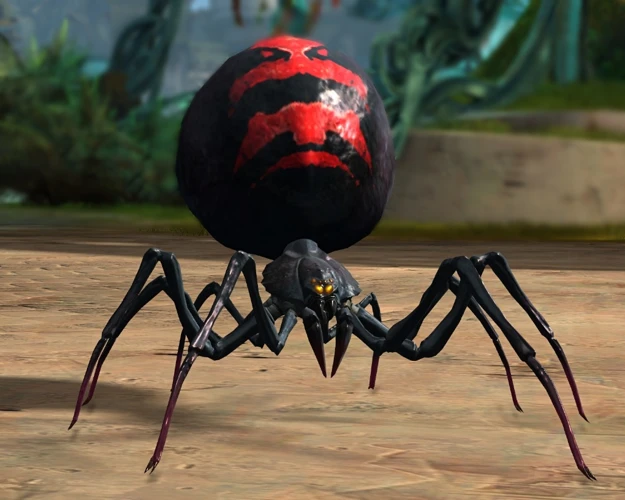
Juvenile Black Widow Spiders are found in many different parts of the world, including the United States. They can be found in a variety of habitats, including forests, fields, and even in residential areas. These spiders tend to prefer warm and dark environments, which is why they are often found in structures such as barns, sheds, and garages.
Outdoors: When outdoors, juvenile black widow spiders can be found living in dark, sheltered areas, such as under rocks or in holes in the ground. They may also be found in dense vegetation, such as bushes and shrubs, where they can spin their webs to catch prey.
Indoors: Juvenile black widow spiders can also be found indoors in homes and other buildings. They tend to hide in dark and cluttered areas, such as closets, basements, and attics. They may also hide in clothing or bedding, so it’s important to be careful when handling these items.
Geographic Locations: Juvenile black widow spiders are found throughout the United States, but are most commonly found in the southern states, including California, Arizona, Texas, and Florida. These spiders also inhabit parts of Central and South America, as well as Australia.
It is important to take precautions when exploring areas where black widow spiders may be present. Wearing long pants and sleeves, as well as gloves, can help reduce the risk of being bitten. When handling items that may have been in contact with these spiders, such as outdoor gear or stored clothing, it’s important to shake them out thoroughly before use. If you find a juvenile black widow spider in your home or yard, it’s best to contact a professional pest control service to safely remove it.
Dangers of Juvenile Black Widow Spiders
Juvenile black widow spiders are known for their venomous bites, which can cause serious health complications in humans. The venom of a black widow spider contains neurotoxic elements that affect the central nervous system and can lead to severe muscle cramps, pain, and spasms. In rare cases, the bite of a juvenile black widow spider can even lead to death.
When a juvenile black widow spider bites, it injects a small amount of venom that affects the victim’s nervous system immediately. The bite site usually feels like a pinprick initially. The venom can cause pain that spreads to other parts of the body, including the abdomen, chest, and back. The pain can become severe and last for several days. The venom can also lead to muscle cramps and spasms that can make it difficult to move.
In addition to the physical symptoms, a bite from a juvenile black widow spider can also cause psychological distress. Anxiety, restlessness, and irritability are common psychological symptoms of black widow spider bites.
It is essential to seek medical attention immediately if you suspect that you have been bitten by a black widow spider, especially if you experience severe symptoms like difficulty breathing, chest pain, or abdominal cramps. An antivenom is available to treat black widow spider bites, which can prevent further damage to the nervous system.
Prevention is the best strategy for avoiding the dangers of juvenile black widow spiders. Keep your home and surroundings clean and free of clutter to avoid creating habitats for spiders. Wear protective clothing and gloves if you are working in areas where black widow spiders are known to be present. Be cautious when handling woodpiles, rocks, or lawn debris.
While juvenile black widow spiders may be small in size, they have a reputation for producing venomous bites that can cause serious health complications. It is crucial to take all necessary precautions to avoid encounters with these spiders and to seek medical attention immediately if you suspect you have been bitten.
Conclusion
After learning about the distinct physical characteristics of juvenile black widow spiders and how to identify them, it is imperative to exercise caution when encountering these spiders. While they may appear small and harmless, juvenile black widows are just as dangerous as their adult counterparts, capable of injecting venom that can cause severe symptoms and even fatalities in some cases.
It is important to note that black widow spiders will only bite in self-defense, so avoiding contact with them is the best course of action. If you find a juvenile black widow spider in your home or outdoor living space, it is best to contact a pest control professional to safely remove the spider and prevent infestations.
Through education and awareness, we can better protect ourselves and our families from the potential dangers of juvenile black widow spiders. By understanding their physical characteristics, identifying their presence, and taking necessary precautions, we can coexist with these remarkable creatures in a safe and responsible manner.
Remember, when it comes to juvenile black widow spiders, prevention is key. Take the necessary steps to ensure that you and your loved ones are safe from harm, and always exercise caution when encountering these fascinating, yet potentially dangerous, arachnids.
Frequently Asked Questions
What is the lifespan of a juvenile black widow spider?
The lifespan of a juvenile black widow spider is typically around 1 year.
How can you differentiate between male and female juvenile black widow spiders?
It can be difficult to differentiate between male and female juvenile black widow spiders. However, female spiders are typically larger with rounder abdomens, while males are smaller with elongated abdomens.
Do juvenile black widow spiders have venom?
Yes, juvenile black widow spiders do have venom. While their bites may not be as dangerous as an adult’s bite, they should still be taken seriously.
At what age do black widow spiders become sexually mature?
Black widow spiders typically reach sexual maturity between 3-4 months of age.
Can juvenile black widow spiders lay eggs?
No, juvenile black widow spiders are not capable of laying eggs until they reach sexual maturity.
What is the typical habitat of juvenile black widow spiders?
Juvenile black widow spiders can be found in a variety of habitats, including forests, deserts, and urban areas.
What is the diet of a juvenile black widow spider?
Juvenile black widow spiders primarily feed on insects such as flies, mosquitoes, and beetles.
Do juvenile black widow spiders stay with their mothers?
No, juvenile black widow spiders do not stay with their mothers. They are independent and will go off on their own once they hatch from the eggs.
How can you prevent a juvenile black widow spider infestation?
To prevent a juvenile black widow spider infestation, make sure to keep your home clean and clutter-free, seal any cracks or gaps in your walls, and eliminate any sources of standing water outside.
Can the venom from a juvenile black widow spider be deadly?
While the venom from a juvenile black widow spider may not be as potent as that of an adult’s, it can still cause serious health complications in certain individuals. It’s important to seek medical attention if you suspect you have been bitten by a black widow spider.

